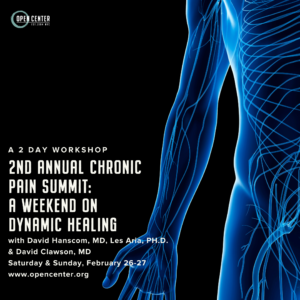2nd Annual Pain Summit – Feb 26th and 27th, 2022

There is a growing group of health care professionals who are determined change the current trajectory of medical care. There is an ever-increasing burden of chronic mental and physical disease1, current approaches are not working, yet we are continuing to embrace them.
The core of chronic disease
Chronic disease is created by your body’s sustained exposure to stress hormones, increased metabolism (fuel consumption), and inflammation. The term is for this situation is, “threat physiology.” The solution lies in learning methods to bring your body into safety physiology, which is necessary for regeneration and healing.
An informal workgroup was created in early 2020 consisting of research scientists and clinicians. We meet twice a month for an hour and have discovered that there is deep research documenting the effects of chronic stress on your body.2,3,4 Historically, these scientists have not had a consistent forum to communicate with each other and most of this knowledge has not entered clinical care.
A deeper understanding of the nature of chronic disease, including chronic mental and physical pain, offers possibilities of solutions. Indeed, many clinicians have watched many patients break free from chronic pain as they have learned the principles and tools to alter their body’s physiology from threat to safety.
Is your body a parked car?
A parked car has no “symptoms.” You have to start it so see what is going on and then systematically test it if it is not running well. But what if it is a new car that runs out of gas, or the wrong fuel was put into the tank? What if you drove it in second gear for days at 80 mph? There will be “symptoms” before there are structural changes from it breaking down.
Of note, your body is never “turned off.” In fact, the complexity of interactions happens at around 20-30 million bits of information per second.5 It is well-beyond human comprehension about how it all works together although we are gaining some ground. We have no clue about human consciousness. We know rough concepts about what part of the brain lights with what input. One of my more skeptical spine fellows pointed out that current technology is a start, but he likened it to seeing what a person is making for dinner from a plane flying at 35,000 feet without magnification.
The myth of MUS (Medically Unexplained Symptoms)

How would you feel if you tried to run a marathon without any training? What if I decided to play NFL football, even for one play? My body is “normal” (could be better) but I would quickly develop symptoms. Most bodily symptoms, illness, and disease are physiological issues and not structural. Medicine has gone completely the opposite direction, addressing most problems as structural, and if they can’t “find” anything, it must not be “real.” There is even a new term that arose in 2002 called, “MUS” (Medically Unexplained Symptoms).6 That could not be farther from the truth. Looked at from the perspective of the body’s function, the correct term would be, “MES” (Medically Explained Symptoms).
This summit brings together pioneers of many disciplines of care who have dedicated their lives and careers to making life better for everyone – providers and patients. You will hear the research and data directly from them. I will warn you that you may not understand some of the deeper data in some of the presentations, but you will definitely get a feel of the concepts.
A letter from some of the presenters
Thank you so much for joining us for this paradigm-shifting two-day virtual Summit about the common basis for chronic disease, including chronic pain.
Stephen Porges, Les Aria, DR Clawson, and David Hanscom have been working together with an extended community of doctors, scientists, and researchers to better understand each other’s fields of expertise and how they fit into addressing chronic pain. It has been fascinating and exciting to see the evolution of so many concepts and how they fit together in a cohesive model.
The Speakers
This group of speakers has been researching and documenting best practices around solving chronic pain. They include EAET (Emotional Awareness and Expression Therapy), PRT (Pain Reprocessing Therapy), and ISTDP (Intensive Short-Term Dynamic Psychotherapy). They developed, refined, and documented the effectiveness of these approaches.
- Howard Schubiner, MD – EAET, PRT
- Tor Wager, PhD – Documented the effectiveness of PRT with fMRI’s
- Allan Abbass, MD – ISTDP
- Yoni Ashar, MD – PRT
These speakers are true pioneers in their fields.
- Steven Hayes, PhD – Founder of ACT (Acceptance and Commitment Theory)
- Angelos Halaris, MD – Early pioneer in the field of psychoneuroimmunology
- Richard Gevirtz, PhD – Deep research documenting the role of the autonomic nervous system in the creation of disease.
- Stephen Porges, PhD – Originator of the Polyvagal Theory
Some researchers that have made core contributions are:
- Sue Carter, PhD – International expert on oxytocin/ vasopressin
- Naomi Eisenberger, PhD and Robert Lustig, MD – renowned for linking mental health to physiology, metabolism, and neural circuitry.
Clinicians who are presenting the implementing these ideas include some of the above speakers and:
- David Clawson, MD – physiatrist/ chronic pain/ rehab
- Nicole Sachs, LCSW – leader in mind/ body medicine
- Steve Overman, MD – rheumatology
- Les Aria, PhD – chronic pain/ clinical psychologist
- David Hanscom, MD – orthopedic spine surgeon
Bruce Lipton, PhD is the author of the “Biology of Belief” who was also a pioneer in presenting many of these ideas over 30 years ago.5 He is the final speaker. What is fascinating is how modern neuroscience has confirmed many of his concepts. Your belief systems affect the expression of your genetic code (epigenetics), your inflammatory markers, the function of the mitochondria (fuel generators in each cell), and are connected with many chronic disease states.
Mental threats are the bigger problem
This brings us to the second day where we present the data on how mental stress creates sustained threat physiology, and the result is many physical and mental symptoms, including chronic pain.
Bringing so many disciplines together has been deeply rewarding and enriching for all of us and we hope it will be for you too. Pull up a comfortable chair and immerse yourself in the weekend. We are looking forward to exploring these ideas together and setting the foundation for next year’s progression of these concepts.
The Summit is intended to present these emerging ideas to a wide audience and further deepen the cross-fertilization of ideas amongst the participants. Whether you are a doctor, health professional working with chronic pain patients, caregiver, sufferer yourself, or a basic science researcher, you will discover a different way of looking at the source of the issue as well as some innovative solutions.
Best regards,
David Hanscom
Steve Porges
Les Aria
DR Clawson
The Summit
Many of the presenters have educational materials, books, courses, and apps that are useful for both clinicians and patients. They will be organized, and links provided at the course.
You can register here. The Summit will be recorded and with registration the recordings will be available for 30 days after the conference.*
*CME credits are available only for those who attend the live conference.
This is not just another pain summit. It is the coming together and flow of innovative ideas and concepts. Be a part of our efforts to bring medicine closer to practicing and implementing known and documented effective interventions for chronic mental and physical disease.
References:
- O’Neill Hayes T and S Gillian. Chronic Disease in the US: A Worsening Health and Economic Crisis. AmericanActionForum.org, September 10th, 2020.
- Dantzer R, et al. Resilience and immunity. Brain, Behavior, and Immunity (2018); 74:28-42.
- Cole SW, et al. Social regulation of gene expression in human leukocytes. Genome Biology (2007); R189. doi: 1086/gb-2007-8-9-r189
- Naviaux R. Perspective: Cell danger response Biology—The new science that connects environmental health with mitochondria and the rising tide of chronic illness. Mitochondrion (2020); 51:40-45.
- Lipton, Bruce. The Biology of Belief. Hay House, Los Angeles, CA, 2016.
- Edwards TM, et al. The treatment of patients with medically unexplained symptoms in primary care: A review of the literature. Mental Health and Family Medicine (2010); 7:209-221.
